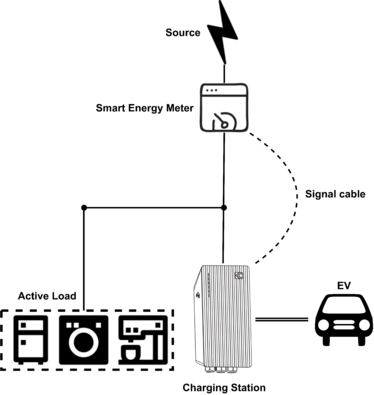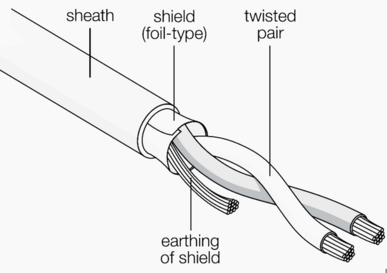Difference between revisions of "Dynamic Load Balancing"
| (27 intermediate revisions by 3 users not shown) | |||
| Line 1: | Line 1: | ||
| + | == DYNAMIC LOAD BALANCING == | ||
| + | TeltoCharge have the ability to communicate with dedicated smart energy meter and regarding to its readings, adjust used electrical power. Such functionality allows to protect house electrical grid from overload in peak hours and optimize energy usage to meet user habits. Smart energy meter should always be installed in source electrical cabinet as showed below. | ||
| + | [[File:Dynamic Load Balancing Conection Schematic.png|alt=|center|frameless|395x395px]] | ||
| − | ''' | + | ==== Smart meter and TeltoCharge communication ==== |
| − | + | Smart meter and TeltoCharge communicates via Modbus RS-485 protocol. In order to achieve smooth communication, it is recommended to use communication cable according to this protocol. Check example below | |
| − | [[ | + | [[File:TeltoCharge DLB CableExample.png|center|frameless|387x387px| |
| + | |||
| + | |||
| + | ]]'''Note:''' ''Communication cable should be integrated with power cable.'' | ||
| + | |||
| + | == Supported energy meters == | ||
| + | In order to strive for wider applicability and compatibility, we constantly test and add new supported devices into list. All of the supported Energy meters and schematics how to connect them are provided below. | ||
| + | |||
| + | === TeltoCharge supported smart energy meters === | ||
| + | |||
| + | {| class="wikitable" style="text-align: center; border: 1px solid #dddddd; font-family: arial, sans-serif; width: 60%;" | ||
| + | |- | ||
| + | ! style="background-color: #0054A6; color:#FFFFFF; padding: 8px;" | Energy meter manufacturer | ||
| + | ! style="background-color: #0054A6; color:#FFFFFF; padding: 8px;" | Technical information | ||
| + | ! style="background-color: #0054A6; color:#FFFFFF; padding: 8px;" | Configuration in mobile application | ||
| + | ! style="background-color: #0054A6; color:#FFFFFF; padding: 8px;" | Wiring scheme | ||
| + | |||
| + | |- | ||
| + | | style="padding: 2px;" | Carlo Gavazzi series 1-3 <br> | ||
| + | | style="padding: 2px;" | [[EM and ET models]] <br> | ||
| + | | style="padding: 2px;" | [[Carlo Gavazzi settings]] | ||
| + | | style="padding: 2px;" | [https://wiki.teltonika-energy.com/view/EM_and_ET_models#Carlo_Gavazzi_meters_wiring: METER -> TELTOCHARGE] <br> | ||
| + | |||
| + | |- | ||
| + | | style="padding: 2px;" | Siemens PACxxxx <br> | ||
| + | | style="padding: 2px;" | [[PAC models]] <br> | ||
| + | | style="padding: 2px;" | [[Siemens settings]] | ||
| + | | style="padding: 2px;" | METER -> TELTOCHARGE <br> | ||
| + | |||
| + | |- | ||
| + | | style="padding: 2px;" | ABB A4x ; B2x <br> | ||
| + | | style="padding: 2px;" | [[A and B models]] <br> | ||
| + | | style="padding: 2px;" | [[ABB settings]] | ||
| + | | style="padding: 2px;" | METER -> TELTOCHARGE <br> | ||
| + | |||
| + | |- | ||
| + | | style="padding: 2px;" | Eastron SDMxx <br> | ||
| + | | style="padding: 2px;" | [[SDM models]] <br> | ||
| + | | style="padding: 2px;" | [[Eastron settings]] | ||
| + | | style="padding: 2px;" | METER -> TELTOCHARGE <br> | ||
| + | |||
| + | |- | ||
| + | | style="padding: 2px;" | Inepro PRO380 <br> | ||
| + | | style="padding: 2px;" | [[PRO model]] | ||
| + | | style="padding: 2px;" | [[Inepro settings]] | ||
| + | | style="padding: 2px;" | METER -> TELTOCHARGE <br> | ||
| + | |||
| + | |- | ||
| + | |||
| + | | style="padding: 2px;" | Chint <br> | ||
| + | | style="padding: 2px;" | [[Chint models]] | ||
| + | | style="padding: 2px;" | [[Chint settings]] | ||
| + | | style="padding: 2px;" | METER -> TELTOCHARGE <br> | ||
| + | |||
| + | |- | ||
| + | |||
| + | | style="padding: 2px;" | Entes <br> | ||
| + | | style="padding: 2px;" | [[ES models]] | ||
| + | | style="padding: 2px;" | [[Entes settings]] | ||
| + | | style="padding: 2px;" | METER -> TELTOCHARGE <br> | ||
| + | |- | ||
| + | | style="padding: 2px;" | Acrel <br> | ||
| + | | style="padding: 2px;" | [[Acrel models]] | ||
| + | | style="padding: 2px;" | [[Acrel settings]] | ||
| + | | style="padding: 2px;" | METER -> TELTOCHARGE <br> | ||
| + | |- | ||
| + | |||
| + | | style="padding: 8px;" colspan="4" | ''More coming soon...'' | ||
| + | |- | ||
| + | |||
| + | |||
| + | |||
| + | |} | ||
| + | |||
| + | [[Category: Advanced Topics]] | ||
Latest revision as of 15:34, 24 November 2023
Main Page > TeltoCharge > Advanced Topics > Dynamic Load BalancingDYNAMIC LOAD BALANCING
TeltoCharge have the ability to communicate with dedicated smart energy meter and regarding to its readings, adjust used electrical power. Such functionality allows to protect house electrical grid from overload in peak hours and optimize energy usage to meet user habits. Smart energy meter should always be installed in source electrical cabinet as showed below.
Smart meter and TeltoCharge communication
Smart meter and TeltoCharge communicates via Modbus RS-485 protocol. In order to achieve smooth communication, it is recommended to use communication cable according to this protocol. Check example below
Note: Communication cable should be integrated with power cable.
Supported energy meters
In order to strive for wider applicability and compatibility, we constantly test and add new supported devices into list. All of the supported Energy meters and schematics how to connect them are provided below.
TeltoCharge supported smart energy meters
| Energy meter manufacturer | Technical information | Configuration in mobile application | Wiring scheme |
|---|---|---|---|
| Carlo Gavazzi series 1-3 |
EM and ET models |
Carlo Gavazzi settings | METER -> TELTOCHARGE |
| Siemens PACxxxx |
PAC models |
Siemens settings | METER -> TELTOCHARGE |
| ABB A4x ; B2x |
A and B models |
ABB settings | METER -> TELTOCHARGE |
| Eastron SDMxx |
SDM models |
Eastron settings | METER -> TELTOCHARGE |
| Inepro PRO380 |
PRO model | Inepro settings | METER -> TELTOCHARGE |
| Chint |
Chint models | Chint settings | METER -> TELTOCHARGE |
| Entes |
ES models | Entes settings | METER -> TELTOCHARGE |
| Acrel |
Acrel models | Acrel settings | METER -> TELTOCHARGE |
| More coming soon... | |||

